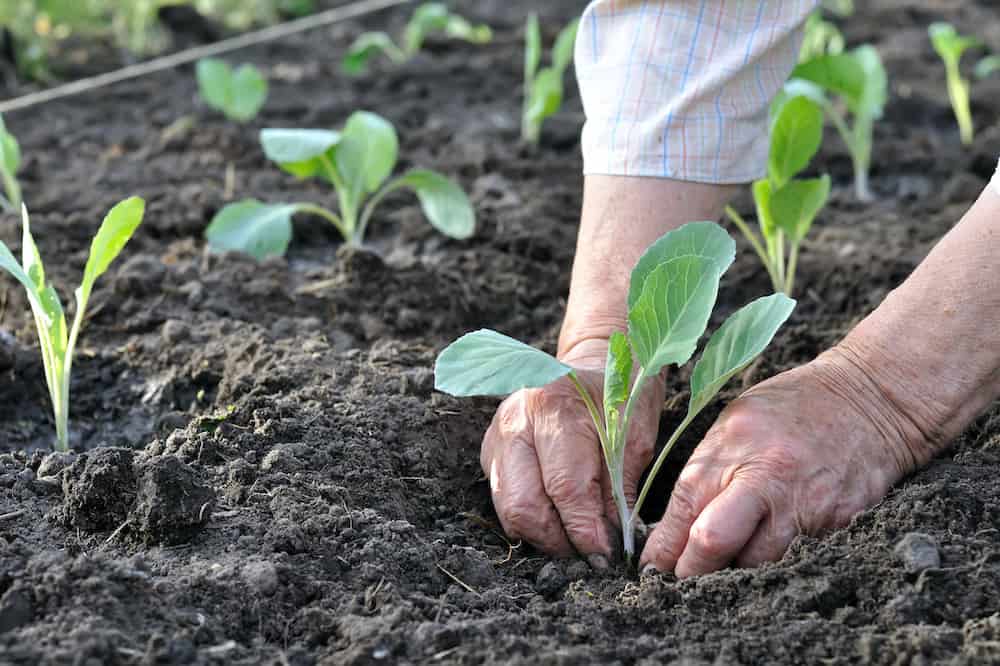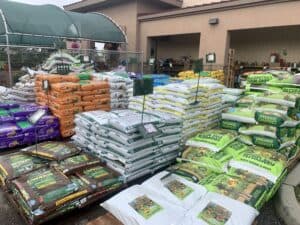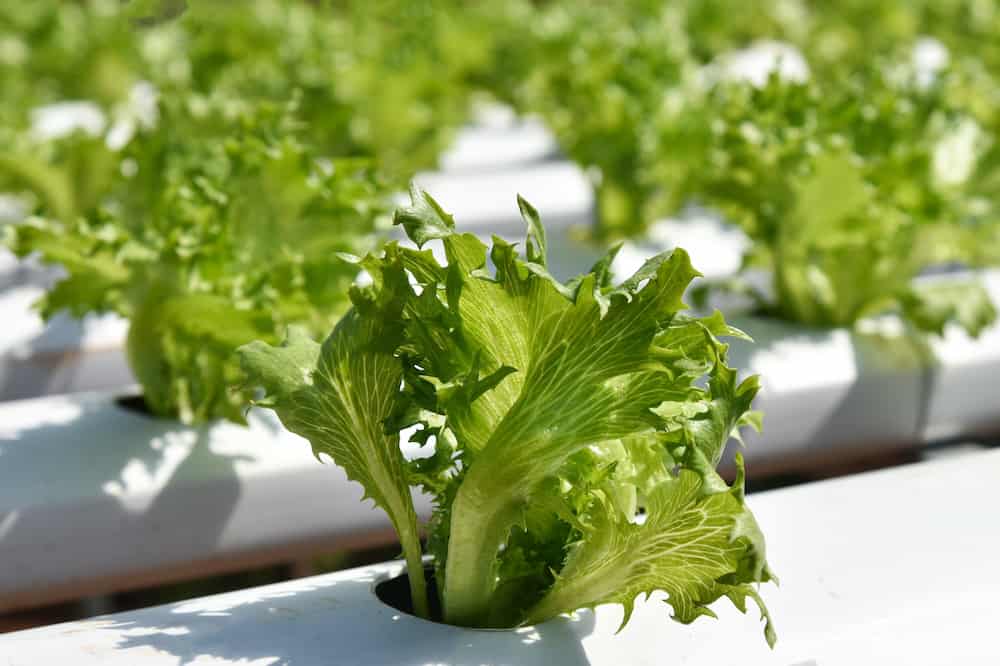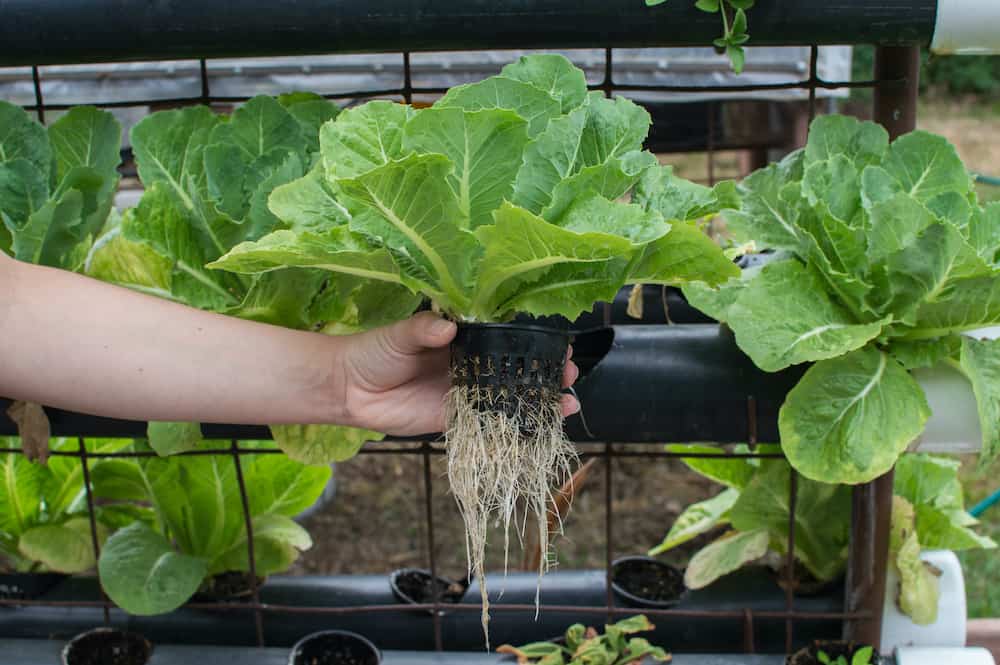You have options when it comes to growing plants. Knowing the differences between using hydroponics vs soil is helpful. Each growth method has advantages. For example, growing plants with hydroponics uses less water than soil gardens. You can typically grow more in less space with a hydroponic garden vs soil.
To find out if soil or hydroponics is the best choice for you, consider the benefits of the two growing methods below.
What Is Hydroponics?
A hydroponic garden refers to growing plants without soil. Instead of soil, roots grow in mineral nutrient solutions in water solvent. The word “hydroponics” means “working water” in Latin.
There are various types of hydroponics systems. Two examples are nutrient film technique and ebb and flow system. Depending on the system you use, you will use different aggregates also called growing mediums. These can include clay pellets, coconut coir, and more.
Plants grow in a hydroponic nutrient solution that feeds the plants. This is a liquid which feeds the roots with a mixture of vitamins and minerals. It includes calcium, phosphorus, and nitrogen. It’s what fertilizer is to soil.
There will be different nutrients depending on what you are growing. People buy chemical solutions or make their own DIY nutrient solution.
Some of the best plants for hydroponics includes cucumbers, strawberries, lettuce, spinach, and hydroponic tomatoes, among many others.
Growing in water vs soil
With careful monitoring, growing in water instead of soil enables people to manipulate the environment to achieve faster growth and often better yields.
Hydroponics is designed to help grow food with less water. Many people choose hydroponics instead of soil because plants need less water to grow. It’s a good choice in areas without access to water.
In addition, with hydroponics, you won’t have to consider starting garden where soil is poor.
Another advantage of hydroponics instead of soil is that you can grow in unpredictable weather or harsh climates. If you live in a moderate climate, you may be able to grow hydroponically outdoors year round.
If you live in a climate with four seasons, you can grow indoors in your home with grow lights, or set up a hydroponic greenhouse hydroponic system. In this way, you can enjoy yields throughout the year.
Hydroponics gives you the opportunity to grow vertically in stacked rows. This is called vertical farming. In general, you can grow more in a smaller space than you can in soil.

- When considering soil vs hydroponics, consider how aesthetically pleasing the garden will be.
Is Soil or Hydroponics Better?
Although more conventional ways of growing can be easier for some, there are many significant benefits to hydroponics. Here are a few of the reasons why using hydroponics instead of soil is an excellent choice for growing a garden.
1. Space Requirements
Traditional soil gardening takes up quite a bit of yard space, whether you are growing in the ground or garden bed. In addition, growing crops in pots and planters will take up more space than hydroponics to get the same yield.
You can grow more in less space with hydroponics. This is because the plant doesn’t require soil to get the nutrients it needs. Instead, the solution created for the plant is given to it directly. This circumvents the need for long roots like in soil.
Since the plants don’t need the soil to transport the nutrients to them, you don’t need as much room. As long as you have enough for the mineral solution and the plant, the plant can grow successfully.
Vertical Farming
Hydroponics is often called vertical farming. This is because hydroponic systems are typically set up vertically in stacked layers. You can optimize space and plant growth with vertical farming because you can grow up (vertically) instead of horizontally.
When building DIY hydroponic PVC systems most setups are vertical. This means you would have rows of containers going up and down instead of taking up additional ground space. In addition to hydroponics, other vertical farming methods are aquaponics and aeroponics.
How Much Space Will You Need?
The space needed will depend on the plant. Using lettuce as an example, when growing multiple heads of lettuce hydroponically, you would need at least a few feet of unused soil.
On the other hand, with hydroponics, you will only need a few rows of piping to hold the nutrient solution. This will allow you to have multiple heads of lettuce in a single foot. As such, you can save a few feet of space for every plant you grow.
You will also be able to grow the plants closer together. In turn, you’ll have more plants in less space, while already saving space. How I built hydroponics system

2. Nutrition for Plants
When comparing soil versus hydroponics, another factor is the nutrients your plants will get. With hydroponics, you can tailor the nutritional requirements for exactly what you are growing. In soil gardening, you will need to enrich the soil and choose from among different options. There is top soil, regular soil, soil that’s amended with compost, and more.
Even enriching the soil with compost and whatever else you add — potting soil, vermiculite, peat moss, manure, filler soil, composted mulch, etc. — you may not have the optimum nutrients like you can in hydroponics.
3. Water Consumption
Water isn’t always readily available. In addition, it’s a natural resource that can come at a high cost when you grow lots of plants. If you don’t have a rainwater collection system, growing hydroponically instead of in soil may be a better choice.
Hydroponics is designed grow more with less water. This will save water for the environment and will keep your water bills lower. Hydroponic gardens use up to 10 times less water than soil gardens. doesn’t use up too much water, and it also keeps the plant from getting more than what it needs.
This is due to the reservoir system that keeps the nutrients in the container. When the plant gets enough, the rest of the nutrients are stored there until they’re needed again. Plus, the reservoir is not open to the sun, so no evaporation occurs.
With soil gardening, you have to worry about over-watering or under-watering.
4. Weeding
Another benefit of hydroponics is that with no soil in the garden, you will not have any weeds. Weeds only grow in soil. Without the soil to grow in, they can’t exist. In addition to being a nuisance, weeds take away nutrients that are supposed to be for your plants.
With hydroponics, you won’t need to worry about pulling weeds. Also, without weeds using some of their nutrients, your plants will grow better.
5. Insects and Critters
Oftentimes, insects will invade plants growing in a soil garden. Depending on your soil and what you are growing, growing in soil attracts insects. Unless you are checking plants daily, you could have insects invading your plants as well as eating your crops.
This is also true with predators invading your garden. Rabbits, ground squirrels, raccoons, birds, and other animals can feast on the plants, leaves, fruits and vegetables in your soil garden. These pests are often more difficult to manage than insects.
Therefore, a disadvantage of soil vs hydroponics is you will attract more critters and insects growing in soil. Your hydroponics garden will likely be closer to your home or maybe inside your home. If you are growing hydroponic plants indoors, there will likely be zero chance of infestations.
If the hydroponic garden is outdoors, there will be less chance for insects and critters to eat them. However, there is the chance for pathogenic and other destructive organisms to invade the roots in hydroponics. Harmful microbes and other pathogens can get into the nutrient system and create root rot, wilting, and other issues.
6. Time
Using hydroponics also gets your plants to grow faster. This can provide you with more than a single harvest in the plant’s growing season.
Because they grow fast, you will see what is affecting their growth right away if something is wrong. As such, making adjustments will have faster results, too, and you can see what is working and what is not.
Some plants, like lettuce, can actually grow and be harvested twice as fast with hydroponics compared to planting in soil.
This could save you a good amount of money on groceries and let you enjoy healthy food conveniently.
7. “Look” of the Garden
When it comes to the look of the garden, this is one area in which people may prefer looking at a traditional soil garden.
Plants growing in soil can look lush and vibrant. It can be very appealing to look at. A hydroponic garden, however, will have a more utilitarian look. It will look more commercial and functional than plants growing in a garden bed surrounded by nature.

- You can grow more with hydroponics in less space than with soil.
How Much Faster Is Hydroponics Than Soil?
The use of hydroponics for plants allows them to grow at a much faster rate. How much faster can you expect them to grow? Using hydroponics will allow your plants to grow anywhere between 30% to 50% faster. This is a huge difference that you will notice quickly.
If all goes well, you would only need to wait for a shorter amount of time for harvest, too. Within a few weeks of growing a few plants, you should expect to see that they are doing better than with soil.
If you don’t notice that your plants are doing well, then you might need to replace the solution in the container sooner. In addition, you won’t worry about critters eating the growing plants which enables them to grow better.
Changing the Nutrient Solution
Although you only need to do this about every two weeks, you will need to change out the solution you use. This is because you don’t want anything to affect the liquid or your plants.
Though hydroponics has lots of benefits, there are some things you need to watch out for.
- The first is that the solution needs to be correct. If the weather heats up quickly, this could change the effectiveness of the solution.
- The pH level is another factor that can be changed to allow the plants to absorb more nutrients.
Changing out the solution and checking the temperature and pH levels will let you know if something is wrong. Adjust the solution to create a better environment for your plants. General hydroponics feeding schedule
If you are growing outside, you will need to ensure the plants are getting the proper sunlight.
Best Hydroponic Nutrients for a Bountiful Grow
Is Hydroponics Cheaper Than Soil?
The cost of hydroponics vs soil depends on a few different factors. Most of the time, though, hydroponics will tend to be a bit costlier overall.
Then again, this is just at first glance. The size of your garden is one major factor. If you have a larger hydroponic garden, it will likely be more cost-effective. With a smaller hydroponic garden, it will be more expensive than using soil.
Initial setup costs
There are initial setup costs when setting up the hydroponics equipment and system, but after that, you can use it for years. If you need LED grow lights, that will also be a cost.
When gardening with soil, you may have expenses. You will need to build out an area for your garden. There are costs involved in building a raised garden bed. You may need to bring in soil. You may need to spend money on a way to keep animals out of garden.
Ongoing costs
You’ll need to factor in ongoing costs for growing with hydroponics. This will depend on the growing medium you choose. In addition, you will have the cost of the nutrient solution which feeds the plants.
Other expenses when growing hydroponically are the ongoing costs for electricity to power the vertical garden. You may also have electricity for grow lights.
Additional expenses with soil gardening will be if you amend the soil with store-bought compost, organic fertilizer, worm castings, and mulch. All of these will add to the cost of soil gardens.
However, if you have your own compost pile and have mulch from your yard, that will save money.
With soil, you’ll also need to account for other things you may need to buy or build such as shade coverings, stakes, trellis and more.
What are you growing
When considering hydroponics vs soil and costs, another thing to think about is what you will be growing. Some plants will need more care. These plants may be more cost effective to grow in a hydroponic garden.
With a traditional garden, if you choose the easiest vegetables to grow, they won’t need as much time and effort. Because they grow fast in soil, it might be a cheaper option.
FAQs about Soil vs Hydroponics
Is soil or hydroponics better?
Growing in soil and growing hydroponically both have their advantages. It really depends on your situation. In general, hydroponics is often considered “better” because it uses less water.
You can grow more in less space because hydroponic systems are stacked vertically. Typically, plants grow faster in hydroponics vs soil because you can control the nutrients you give the plants.
However, you will have costs involved with electricity to power the hydroponic garden. If you need grow lights, you will have energy costs to run those as well.
Also, it’s better to grow some plants in soil instead of with hydroponics. Decide what you want to grow, and check to be sure it’s something you can grow with hydroponics. What cannot be grown hydroponically
Why is growing hydroponically better than growing in soil?
When growing hydroponically, you can grow plants faster, with less water, and in less space than growing in soil.
Do hydroponic plants grow faster than soil?
Because you can control the conditions in order to create the ideal conditions for the plants, hydroponic plants grow faster than in soil.
Hydroponics vs Soil: Which Is Better?
When trying to decide between growing in soil vs hydroponics, you need to consider your situation. If you have a balcony or small area, it might be better to grow hydroponically than in soil. If you already have an area on your property with soil, that might be a better choice to start gardening.
The overall “look” of a soil garden can be more aesthetically pleasing than a hydroponic garden. A hydroponic setup will be more utilitarian and functional in appearance. When choosing between soil or hydroponics, this is something to keep in mind.
Overall, though, hydroponics is gaining in popularity for many reasons. Growing in hydroponics means you can grow more, faster than in soil, in less space.
It’s often a better choice for certain plants, such as lettuce, spinach, tomatoes, etc., than traditional planting.
Soil brings with it several issues that make it harder to garden with. Many of these include weather fluctuations, insects, and pests. You also have to account for how often to water a vegetable-garden as it’s easy to over-water or under-water.
You also have to consider weeds, fertilizer, and more. Oftentimes, it takes more work to succeed when planting with soil.
On the other hand, one of the only issues that come with hydroponics is that it can sometimes be a more expensive option. Still, this can vary. You can save money by building DIY hydroponic systems.
Looking at the big picture, it is safe to say that hydroponics is the winner in this scenario in most cases. With less work to have a flourishing garden, it’s a more efficient option.
Hydroponics can make a huge difference in water usage and food production in areas where both resources are scarce.
Worm Farm – Should You Start One?
The best hydroponic herbs to grow


Though what’s with the nutrients? We all know that home grown tomatoes taste better then the ones from the green houses and I bet they also have more nutrients. Is it similar with hydroponics salads that they might grow faster though are somewhat “plastic” salads such as they just look good, maybe even have the same taste, though don’t provide us with the same nutrients?
It seems like somehow common sense would say that it is foolish to expect the same results from a well kept rich soil with it’s 1000s or millions of micro cultures vs a just roughly, to the most important fertilizers adjusted water culture.